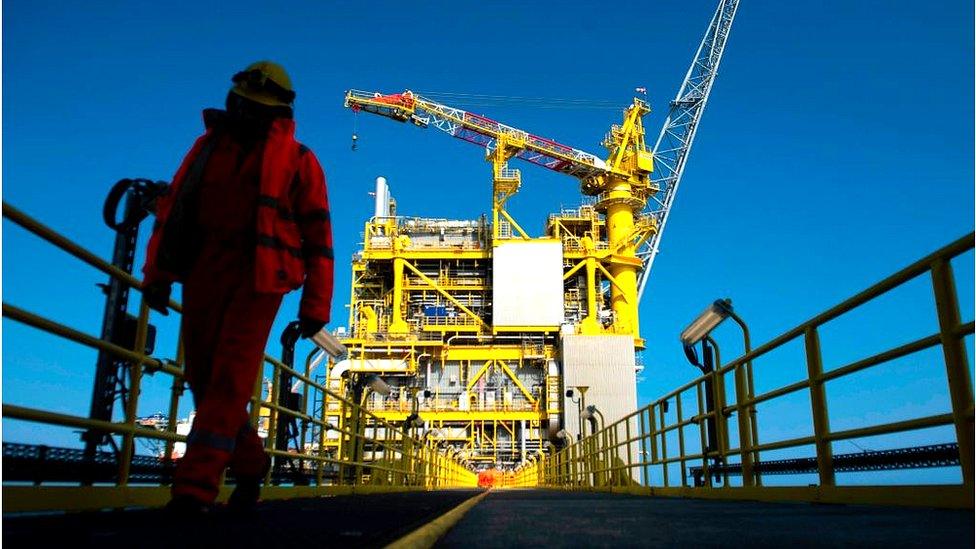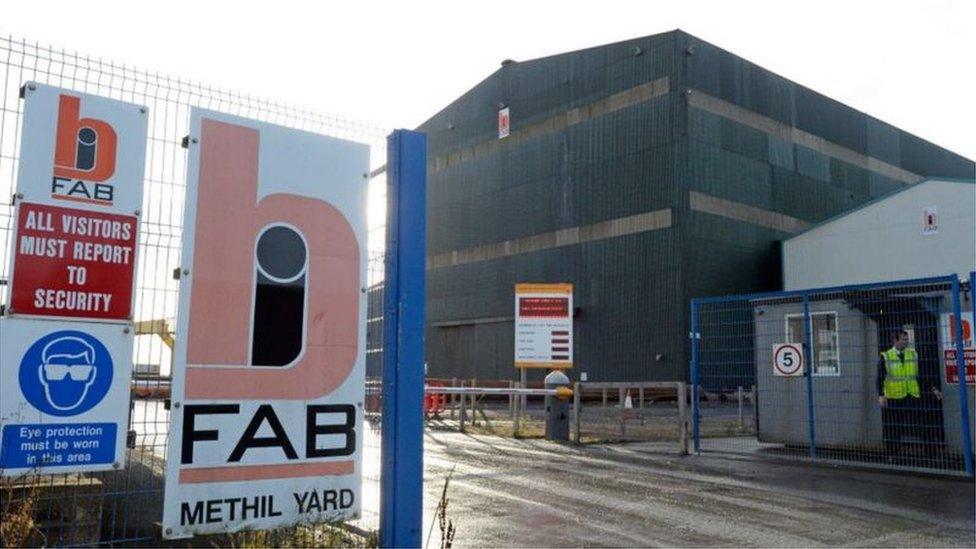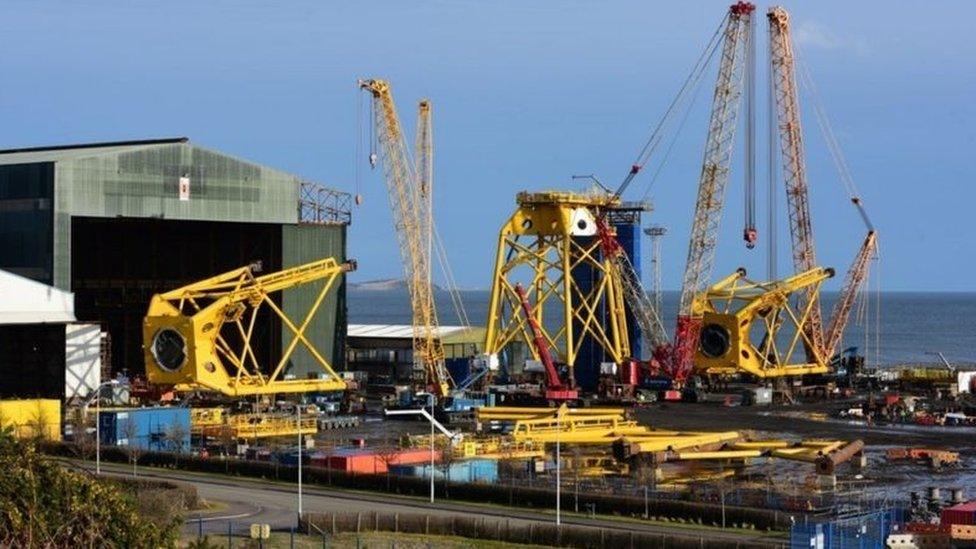The greening of black gold
- Published

Oil exporters are eager to stabilise or push up its price, against the slump in demand from the pandemic and growing pressure for more efficient or lower energy use.
Beyond the short term, the industry isn't just dealing with the familiar boom and bust cycle, but growing pressure for a permanent shift to far lower carbon emissions. It's eager to shape that future and remain part of it.
In the UK, the move to hydrogen power, along with carbon capture, offer an opportunity to the industry to redirect its engineering expertise. Government has to provide the skills and training base, but how much more does it have to do to shape industries, when BiFab - Scotland's best hope for steel fabrication for offshore wind power - can't win any contracts and has now gone into administration?
This isn't just any business cycle for the oil industry. As its major exporters in Opec plus Russia convene this week to decide how best to sustain the price above 40 US dollars, it's not just Covid-19 that's caused the tectonic plates to shift underneath them, and nor will vaccines make the challenge go away.
Climate change, and the political and consumer pressure resulting from it, is forcing much of the industry to think hard about its future and to act.
Exxon Mobil this week joined other fossil fuel majors, including Shell, BP and Chevron, in writing down the value of reserves on a colossal scale: around $80bn between them. The American-based ones are much slower to commit future investment funds to renewable energy, but BP and Shell are eager to redefine themselves.
That revaluing follows a sharp and chaotic drop in the oil price last spring, when Opec-plus-Russia failed to agree a production cut in line with the global demand slump due to the pandemic and lockdown.

Some of the big players in the fossil fuels industry have drastically written down the value of reserves
They later agreed a cut of around 8%. Most have observed their self-denying commitments, and the cut has worked for them. The price of a barrel of Brent crude has recovered since spring, and stabilised. With optimism about vaccines and more demand out of China, it now sits close to $50. But that's more than 25% down this year, and the dollar has been weakening.
Gas has also been priced low, with demand from fuel-burning industry slowing up. Supply has been boosted by new pipelines, and shipments of liquified hydrocarbons.
America's fracking industry can ramp up production quickly, but it's boom and bust in the Texas and Dakota scrublands. When the price drops, it's also the producing "basin" where companies fail. Exxon's $17bn to $20bn write-down reflects a wildly optimistic gamble 10 years ago.
'Keep it in the ground'
That's nothing new to oil, with its breezy confidence that bust surely turns back to boom. Black gold always finds a way back, because it has been inextricably linked with economic growth and prosperity. Until now.
It is now being shunned by some institutional investors, and banks tread warily in dealings with it. Even in Norway, awash with wealth from oil and gas, its gigantic trust fund is no longer backing other countries and foreign companies to keep it pumping.
Environment policy is heading in the same direction, with pressure to reduce subsidies and tax breaks. The Institute for Public Policy Research (IPPR), a London-based left-leaning think tank, has published a report today urging UK and Scottish governments to keep oil and gas in the ground. It wants to see a reversal of the policy of "maximum economic recovery", and chief executives rewarded on the basis of their environmental performance.
This comes with a social message, to soften the economic blow. While it notes that many of the jobs are outside Scotland, 10% of Aberdeen jobs are reckoned to be directly oil-dependent, and 5% in Aberdeenshire. So IPPR offers a plan to avoid managed decline, instead making this a managed transition, somehow achieved with the consent of workers and communities.
As a slogan, "managed transition rather than decline" chimes with industry efforts. As governments in the UK are signing up to ever more ambitious targets for achieving net zero on climate changing emissions, the oil and gas sector is trying to respond with its own plans.

Oil and Gas UK (OGUK) wants to slash its own burning of carbons, reaching net zero by 2050
Oil and Gas UK, which represents it, this week produced its annual economic impact report. In the past, it's been an impressive listing of jobs, investment, production by the millions of barrels per day, and economic impact to benefit us all.
This year, it reads more like a plea for understanding, patience and help with the transition to lower-carbon energy.
It wants to slash its own burning of carbons in the process of producing lots more of them, reaching net zero by 2050. That's made easier by quite a lot of decline expected by then, and also if it can deploy offshore floating wind turbines to power its production platforms.
It argues that even the toughest targets for reducing carbon emissions would still require some oil and lots of gas to supply 46% of global energy needs 20 years from now.
Hydrogen power
If there's to be a big transition to hydrogen - though not yet commercially viable, but in demonstration phase on buses and trains - some will be split from water molecules by wind power. But once wind has replaced nuclear power, and met the demands of battery-driven transport, there will still be a need for gas to create "blue hydrogen" rather than the green, wind-driven variety, converting water to hydrogen at plants along the North Sea coast.
Allied to that, the gas grid network is trialling the use of the current pipe network to carry hydrogen in a trial project in east Fife. Hydrogen can be 10% of the mix with North Sea gas and without any changes to pipework or boilers: that mix alone can cut emissions significantly. Meanwhile, in a separate desktop exercise, the east of Scotland is being scoped out for such conversion.
That depends on capturing gas's carbon emissions and storing them under the seabed - an expensive and complex technology that has had a number of false dawns and inconsistent UK government policy.
Oil and Gas UK reckons that more than £2bn has to be spent to get the industry going in the next decade, and that's just for transport and infrastructure. By 2050, it thinks there will be a need to capture and store annually the equivalent of half the carbon dioxide created by Britain's domestic heating boilers in 2019.
That's going to take engineering know-how, and a knowledge of rock structures under the North Sea will surely help. So the industry is trying to persuade policy makers and the public that it is key to making this happen.
The Acorn project, centred on the St Fergus gas terminal in Aberdeenshire, is the lead prospect for showing how. It was begun two years ago, is scheduled for final investment gateway in a year and to be in operation in 2023.
Having set out its stall on this last year, Oil and Gas UK is seeking also to lead and educate its own members - exploration drillers, producers, oilfield services and the long and varied supply chain - into recognition that they have to make radicals changes, if they haven't already begun.
The sector body is currently negotiating one of those "deals" which have come to characterise Whitehall policy as a series of transactions. Industry ambition for the North Sea Transition Deal is very large.
Oil and Gas UK estimates that the investment needed to achieve government targets on the energy transition are roughly 2% of total national output, or Gross Domestic Product. That comes to around £50bn a year, sustained for the next 30 years.
IPPR points out that such investment should come with a lot of jobs - 1.6m across the UK, including 134,000 in Scotland - and that it is governments' task to ensure training and skills are up to the task.

BiFab has gone into administration after its yards in Fife and on Lewis failed to secure lucrative contracts
BiFab or bust?
The scale of government intervention in the private sector economy is a hot topic in EU-UK post-Brexit talk, and in Downing Street, where the departed Dominic Cummings appeared to have persuaded the prime minister to back far more intervention than usual for Conservatives.
And in Holyrood? That's a question left hanging by the absence of any clear policy on the symbolic great hope for manufacturing tied to offshore renewable power.
BiFab, which has now gone into administration, has been denied the financial guarantee the Scottish government promised and then withdrew. So its three fabrication yards remain mothballed, and scores of jackets for seabed installation are being built in China, Indonesia and the United Arab Emirates.
Economy Secretary Fiona Hyslop says she is barred from offering subsidy of the sort that a commercial firm would or could not offer, and the Scottish government's partner in keeping BiFab afloat, Canadian engineering firm DF Barnes, is being blamed by her for a lack of investment.
It seems odd, at least, that there is a need to be bound by European state aid rules less than a month from full economic Brexit. And it lost the SNP two votes at Holyrood on Wednesday.
But leave that aside for now, because there's a more fundamental question: why Scottish yards are not internationally competitive in the first place: and what is being done about that?
- Published3 December 2020

- Published25 November 2020

- Published25 November 2020

